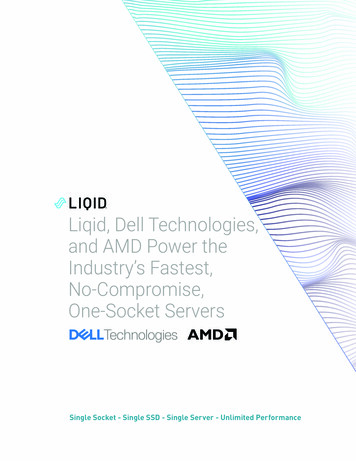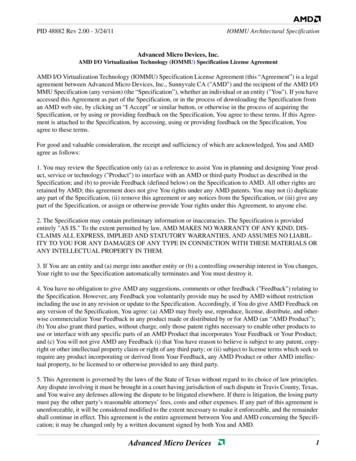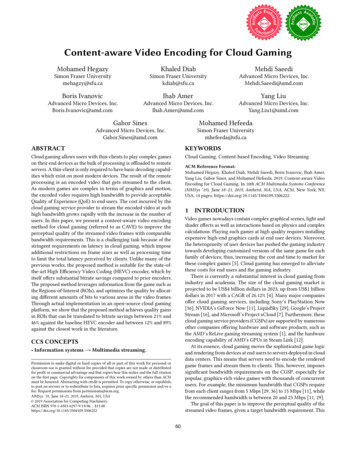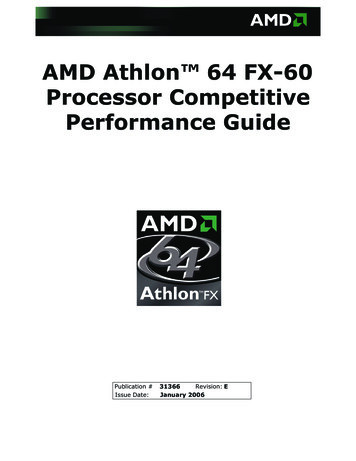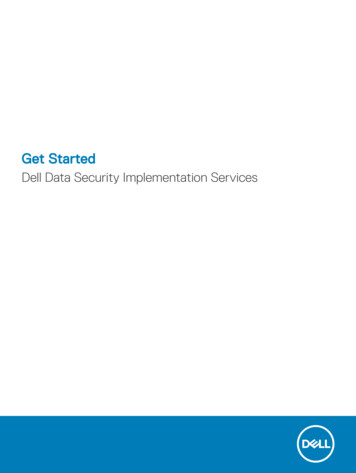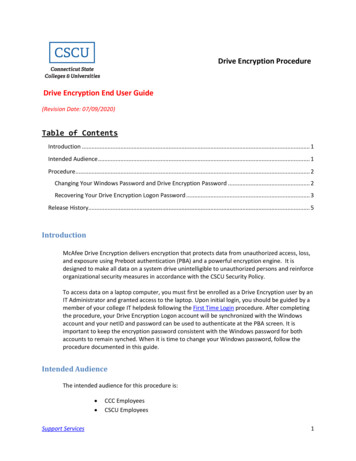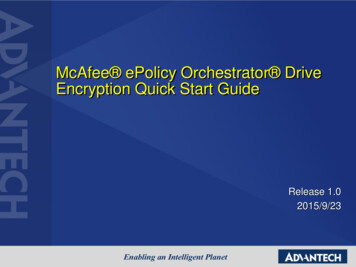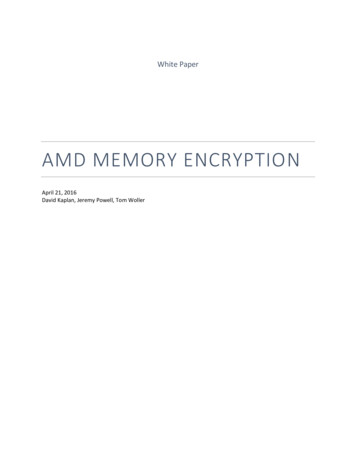
Transcription
White PaperAMD MEMORY ENCRYPTIONApril 21, 2016David Kaplan, Jeremy Powell, Tom Woller
DISCLAIMERThe information contained herein is for informational purposes only, and is subject to change without notice. While everyprecaution has been taken in the preparation of this document, it may contain technical inaccuracies, omissions andtypographical errors, and AMD is under no obligation to update or otherwise correct this information. Advanced Micro Devices,Inc. makes no representations or warranties with respect to the accuracy or completeness of the contents of this document,and assumes no liability of any kind, including the implied warranties of noninfringement, merchantability or fitness forparticular purposes, with respect to the operation or use of AMD hardware, software or other products described herein. Nolicense, including implied or arising by estoppel, to any intellectual property rights is granted by this document. Terms andlimitations applicable to the purchase or use of AMD’s products are as set forth in a signed agreement between the parties or inAMD's Standard Terms and Conditions of Sale.AMD, the AMD Arrow logo, and combinations thereof are trademarks of Advanced Micro Devices, Inc. Other product namesused in this publication are for identification purposes only and may be trademarks of their respective companies. 2016 Advanced Micro Devices, Inc. All rights reserved.
IntroductionThe need for practical security in modern computing systems is greater than ever. The increase insystem complexity, growth of the cloud, and advent of new technologies are all contributing to a computingenvironment that is difficult yet critical to protect. AMD recognizes these serious challenges and hasdeveloped new memory encryption technologies that are designed to address these needs across a variety ofsystems.Secure Memory Encryption (SME) defines a simple and efficient architectural capability for mainmemory encryption. While memory encryption technologies have been used previously in variousspecialized products and industries, SME is a general purpose mechanism that is flexible, integrated into theCPU architecture, scalable from embedded to high-end server workloads, and requires no applicationsoftware modifications.Main memory encryption can be utilized to protect a system against a variety of attacks. While datais typically encrypted today when stored on disk, it is stored in DRAM in the clear. This can leave the datavulnerable to snooping by unauthorized administrators or software or by hardware probing. New non-volatilememory technology (NVDIMM) exacerbates this problem since an NVDIMM chip can be physically removedfrom a system with the data intact, similar to a hard drive. Without encryption any stored information such assensitive data, passwords, or secret keys can be easily compromised.Secure Encrypted Virtualization (SEV) integrates main memory encryption capabilities with theexisting AMD-V virtualization architecture to support encrypted virtual machines. Encrypting virtual machinescan help protect them not only from physical threats but also from other virtual machines or even thehypervisor itself. SEV thus represents a new virtualization security paradigm that is particularly applicable tocloud computing where virtual machines need not fully trust the hypervisor and administrator of their hostsystem. As with SME, no application software modifications are required to support SEV.This document presents a technical overview of the SME and SEV and describes how they can beutilized by operating system (OS), hypervisor (HV), and guest virtual machine (VM) software in a variety ofdifferent environments to protect data in DRAM.
SME Technical OverviewMain memory encryption is performed via dedicatedMemory Readhardware in the on-die memory controllers. Each controllerPTE C-bitincludes a high performance Advanced Encryption Standard(AES) engine that encrypts data when it is written to DRAM,DRAMDataand decrypts it when read as shown in Figure 1: MemoryCPUAES DecryptEncryption Behavior. The encryption of data is done with a128-bit key in a mode which utilizes an additional physicaladdress-based tweak to protect against cipher-text block moveMemory Writeattacks.PTE C-bitThe encryption key used by the AES engine with SMEis randomly generated on each system reset and is not visibleDatato any software running on the CPU cores. This key is managedentirely by the AMD Secure Processor (AMD-SP), a 32-bitmicrocontroller (ARM Cortex -A5) that functions as aCPUDRAMAES EncryptFigure 1: Memory Encryption Behaviordedicated security subsystem integrated within the AMD SOC. The key is generated using the onboard NISTSP 800-90 compliant hardware random number generator and is stored in dedicated hardware registers whereit is never exposed outside the SOC in the clear. Unlike the SEV mode described later, SME does not requirethe software running on the CPU cores to participate in key management.The control over which pages of memory are encrypted is controlled via the OS or HV in the softwaremanaged page tables.UnencryptedEncryptedVirtual AddressVirtual AddressC-bitC-bit0Physical Address471047After memoryencryption is enabled, physical address bit 47(aka the C-bit, as in enCrypted) is utilized tomark if a memory page is protected. The OSor HV sets bit 47 of a physical address to 1 inPhysical Address0the page table entry (PTE) to indicate thepage should be encrypted, causing accessesMemoryMemoryto that memory to be automaticallyencrypted and decrypted by the AES enginein the memory controller.The encryption and decryption of memoryFigure 2: Address Mappingthrough the AES engine does incur a smallamount of additional latency for DRAM memory accesses. The impact of this latency to software is verydependent on the system workload but is estimated to have a very small overall effect on system performance.If only a subset of memory is encrypted, the performance impact will be less as unencrypted accesses generallyincur no additional latency.
SME Use ModelsThis section discusses two different example models by which software can utilize the SME feature. Inthe first model, all of DRAM is encrypted while in the second, only a select region (corresponding to guest VMs)is encrypted.Full Memory EncryptionFull memory encryption is a simple yet compelling model for many computing systems, especiallywhen physical attacks on the system are of concern, including government data centers and/or smaller orremote enterprise data centers that have more limited physical security. With full memory encryption, allDRAM contents are encrypted utilizing the random key which provides strong protection against cold boot,DRAM interface snooping, and similar types of attacks. For systems with NVDIMM, full memory encryptionalso provides protection against an attacker removing a memory module and attempting to extract itscontents.Supporting full memory encryption with SME is accomplished by either the OS or HV setting the C-bitin all DRAM physical addresses in all the page tables. This should include both instruction and data pages, aswell as the pages corresponding to the page tables themselves. In essence, the OS or HV software may viewthe system as having DRAM that starts at address 0x8000 0000 0000. In the case of a HV setting the C-bit toencrypt all physical memory, all the VMs controlled by the HV are encrypted along with the HV and use thesame encryption key.Note that DMA to memory encrypted via SME is supported. From a device standpoint, an encryptedmemory access is just a normal memory access with bit 47 set.Partial Memory EncryptionThe use of the C-bit in the page tables provides the flexibility for the OS or HV to selectively encryptonly a subset of memory if it desires. Doing so still provides physical protection of the encrypted memory, butcan also be used to improve performance on non-sensitive data. In addition, the choice of encrypted vs.unencrypted memory can be used to provide a layer of isolation for critical workloads.
Guest Virtual AddressHost Virtual AddressOne example of this isolation would be a systemwhich only marks memory used by guest VMs asencrypted. This can be done without any modificationGuest Physical AddressC-bit1to the guest VMs whatsoever. By setting the C-bit in allthe nested page table entries corresponding to DRAMC-bitHost Physical Address0Host Physical AddressDRAM(as shown in Figure 3: Encrypted VMs), the hypervisorenables encryption for the VM memory only.Such a scenario could be used to protect VMsEncrypted DRAMagainst a rogue machine administrator.While theadministrator would have access to the hardware andhost system, they would not be able to inspect guestFigure 3: Encrypted VMsVM data even with memory scanning utilities.SME Special ConsiderationsSME provides a straightforward method for software to encrypt some or all memory pages. There aresome important special programming considerations however that must be taken into account when workingwith encrypted memory.The primary consideration is that hardware does not manage coherency between encrypted andunencrypted copies the same page. Therefore, software must be careful when modifying the C-bit of pagesand ensure that if the C-bit of a page needs to be modified, that page must be flushed from the CPU cachesprior to the page table modification.Worth noting is that it is allowed for devices to issue DMA to encrypted memory but like with CPUaccesses, they must set bit 47 of the physical address which is not possible on some 32-bit legacy devices. Tocompensate, software can utilize the IOMMU to re-map device request addresses to addresses with the C-bitset.Additional technical details of the SME feature can be found in the latest copy of the AMDProgrammer’s Manual (APM) volume 2.Transparent SMEWhile SME provides a lot of flexibility for managing main memory encryption, it does require supportin the OS/HV. For systems that desire only the physical protection of SME but run legacy OS or HV software,they may use a mode called Transparent SME (TSME). In TSME, all memory is encrypted regardless of thevalue of the C-bit on any particular page. This mode provides a simple method to enable encryption withoutrequiring software modifications.TSME can be enabled via a BIOS setting on supported platforms. When TSME is used, other memoryencryption features (including SEV) are not available.
Intro to SEV: Complexity and ConsolidationWith advances in both hardware and software, computing systems today are more complex thanever. The size and functionality of software, especially the most privileged kernel-level software responsiblefor security in the system, has increased dramatically. The Linux kernel for instance has grown from less than200k lines of code to almost 22 million lines today.This evolution has also led to moreLinux Kernel lines of codesystems to perform more tasks and do morework on the same hardware. Thisconsolidation has led to many positive resultssuch as the cloud, and virtual data centers onLines of code(Millionis)consolidation than ever before allowingwhich anyone can buy affordable compute20151050time.VersionYet both complexity and consolidationhave a generally negative effect on the securityFigure 4: Kernel Code Sizeof a system. Complex software is harder to verify and is more likely to have bugs which hackers could exploit.A typical Linux system loads close to 5.5MB of kernel code into memory which must be bug-free to avoidcompromising the system.Consolidated systems can also negatively impact security by increasing the attack surface, allowingmany different pieces of software to use the same hardware and share resources like memory. Thiscombination yields a security model which relies on a large amountProgramcode/dataof privileged bug-free code, which coupled with a large attacksurface provides an increased possibility for intrusions.SEV securitylayerTo counter these forces, Secure Encrypted Virtualization is aExisting CPUsecuritylayernew feature being added to the AMD architecture which is designedto better deal with the complexity and isolation needs of modernsystems. SEV enhances isolation through the use of cryptography,encrypting code and data and enables an entirely new securitymodel where code can be cryptographically protected from higherprivileged code such as a hypervisor.Figure 5: Security LayersSEV Security ModelTraditional computing systems have operated using a ring-based security model. In this model, highprivilege code has full access to the resources at its level and of all lower privileged levels.
TraditionalModelIn the SEV model, code executing at different levels (namelyAMD SEVModelhypervisor vs guest) is isolated so neither has access to theresources of the other. Even though the hypervisor level istraditionally “more privileged” than the guest level, SEVHypervisorHypervisorGuestGuestseparates these levels through cryptographic isolation. Thisprovides additional security for lower privileged code,without requiring trust in the high privileged code on whichthe less privileged code is dependent upon for startup andFigure 6: SEV Security Modelexecution. Communication between hypervisor and guest isstill possible, but those communication paths are tightly controlled.Consequently, SEV technology is built around a threat model where an attacker is assumed to haveaccess to not only execute user level privileged code on the target machine, but can potentially executemalware at the higher privileged hypervisor level as well. The attacker may also have physical access to themachine including to the DRAM chips themselves. In all these cases, SEV provides additional assurances tohelp protect the guest virtual machine code and data from the attacker. Note that SEV does not protectagainst denial-of-service attacks against the guest.SEV Use CasesBuilt around the concept of hardware VMs, SEV can be used to enhance security in a variety of usecases. Due to its use of main memory encryption, SEV provides the all of the same security benefits as SMEfor physical attack protection described earlier. In addition, SEV can be used to protect environments such asthe following.CloudThe growth of the cloud and in particular Infrastructure as a Service (IaaS)data centers has made computational power both cheap and affordable. Thisgrowth does not come without security challenges however, as /personnel may not always be trustworthy. This can beparticularly true when dealing with sensitive data, such as health records ortrade secrets. Furthermore, the sharing of hardware amongst multipleEncryptedVMcustomers can raise security concerns for owners of many types of workloads.Despite the best efforts of software designers, there have been manyFigure 7: Encrypted VMs in theCloudexamples of cases where this isolation has failed, leading to the compromise ofsensitive code or data.SEV can be used to increase the level of security in these IaaS clouds by providing better securityisolation, rooted in the hardware itself. While existing security technologies like Microsoft’s BitLocker andLUKS can protect data-at-rest in hard drives, SEV protects data-in-use enabling customer workloads to beprotected cryptographically from each other as well as protected from the hosting software. Even an
administrator with malicious intentions at a cloud data center would not be able to access the data in ahosted VM.SandboxingThrough the use of the hardware VM constructs, SEV isAMD SEV Sandboxingbuilt around an idea of secure sandbox environments whereOperating Systemsoftware can execute and is protected from all other software onthe system. These sandboxes can be as big as a full VM with itsown disk and OS, but they can also be small and used for more finegrained isolation. For example, SEV hardware could be used tocryptographically isolate Docker containers from the host system toApp AApp BApp Cbetter protect confidential data.Figure 8: SandboxingSEV ArchitectureTechnical OverviewSEV is an extension to the AMD-V architecture which supports runningmultiple VMs under the control of a hypervisor. When enabled, SEV hardware tagsall code and data with its VM ASID which indicates which VM the data originatedfrom or is intended for. This tag is kept with the data at all times when inside theSOC, and prevents that data from being used by anyone other than the owner.While the tag protects VM data inside the SOC, AES with 128 bit encryptionprotects data outside the SOC. When data leaves or enters the SOC, it isencrypted/decrypted respectively by hardware with a key based on the associatedtag.Each VM as well as the hypervisor is associated with a tag, and consequentlyan associated encryption key. Because of the tag and memory encryption, data isFigure 9: SEV Architecturerestricted to only the VM using that tag. If that data is accessed by anyone else, including the hypervisor,they will only be able to see the data in its encrypted form. This provides strong cryptographic isolationbetween the VMs, as well as between the VMs and the hypervisor.Encrypted MemorySEV uses the same high performance memory encryption engine as the SME feature describedearlier. It also uses the same C-bit in the page tables to mark pages as encrypted, although with someadditional restrictions.One of the key features of SEV is that guest VMs are able to choose which data memory pages theywould like to be private. This choice is done using the standard CPU page tables, and is fully controlled by theguest. Private memory is encrypted with the guest-specific key, while shared memory may be encrypted withthe hypervisor key. This feature allows VMs to mark selected pages of memory data they want to keep
GuestPage ial (private), and others to be used for communication with other VMsor the hypervisor. In a typical arrangement, the guest would map all of its codeData Memory(Private)and data as private, except for specific shared pages that it chooses to expose.For security, SEV hardware does require certain types of memory (includingData Memory(Shared)instruction pages and page tables) to always be private to protect the VM.An example communication configuration is shown in Figure 10. In thisexample, the SEV-enabled guest and hypervisor communicate through memorythat both entities mark as shared. All other guest memory is encrypted withHVMemory(Shared)the guest’s key (which the HV cannot use). Any memory the HV does not usefor direct guest communication is encrypted using the SME feature describedearlier.Memory(SME Encrypted)Key ManagementThe security of SEV is highly dependent on the security of the memoryFigure 10: Guest/HVCommunication Exampleencryption keys. Exposure to malicious entities, such as a malicious or buggyhypervisor, can endanger the SEV protected guest. While the hypervisor mustmanage the guest and its resources, the hypervisor must never gain knowledge of the memory encryptionkeys themselves. The SEV firmware that runs within the AMD-SP provides a secure key managementinterface to accomplish this. The hypervisor uses this interface to enable SEV for secure guests and performcommon hypervisor activities such as launching, running, snapshotting, migrating, and debugging a guest.To protect SEV enabled guests, the firmware assists in the enforcement of three main securityproperties: authenticity of the platform, attestation of a launched guest, and the confidentiality of the guest’sdata.Authenticating the platform prevents malicious software or arogue device from masquerading as a legitimate platform. The authenticityAMDof the platform is proven with its identity key. This key is signed by AMD toIdentityKeydemonstrate that the platform is an authentic AMD platform with SEVcapabilities. It is also signed by the owner of the platform to show whoadministers and owns the machine to the owners of guests or to otherinstances of the firmware on remote platforms.SEV FirmwarePlatformOwnerFigure 11: Authenticating the FirmwareAttestation of the guest launch proves to guest owners that theirguests securely launched with SEV enabled. A signature of various components of the SEV related gueststate—including initial contents of memory—is provided by the firmware to the guest owner to verify thatthe guest is in the expected state. With this attestation, a guest owner can ensure that the hypervisor did notinterfere with the initialization of SEV before transmitting confidential information to the guest.An example of this process is shown in Figure 12. Initially, the guest owner provides the guest imageto the cloud system. The SEV firmware assists in launching the guest and provides a measurement back to
the guest owner. If the guest owner deems this1. Guest ImageGuestOwnerSEVFirmware3. Measurement2. Launch4. Disk Decryption KeyGuestFigure 12: Guest Attestation Examplemeasurement correct, they in turn provide additional secrets(such as a disk decryption key) to the running guest allowingit to proceed with start-up.Confidentiality of the guest is accomplished byencrypting memory with a memory encryption key that onlythe SEV firmware knows. The SEV management interfacedoes not allow the memory encryption key—or any othersecret SEV state—to be exported outside of the firmware without properly authenticating the recipient. Thisprevents the hypervisor from gaining access to the keys and consequently the guest’s data.The interface also provides a mechanism to migrate the guest data to another SEV capable platform.During this operation, the guest’s memory contents remains encrypted during transmission. Once the remoteplatform is authenticated, the SEV firmware sends the guest’s memory encryption keys securely so theremote platform can run the guest itself. This transport mechanism allows a hypervisor to implementmigration and snapshot functions securely with SEV enabled.SEV Software ImplicationsHypervisorAs with traditional virtualization, SEV continues to rely on the hypervisor for many VM functions suchas device emulation and scheduling, but reduces the reliance on the hypervisor for security. A guest runningwith SEV enabled still uses the hypervisor as needed, but is able to protect itself by marking memory pages asprivate when they are not intended to be shared outside the VM.During runtime the hypervisor communicates with the AMD-SP in order to coordinate themanagement of memory encryption keys. This communication is done via the AMD-SP driver and involvestasks such as informing the AMD-SP when a VM is about to be run, thus allowing the AMD-SP to load theappropriate encryption key into the AES-128 encryption engine. The hypervisor also communicates with theAMD-SP to establish a secure mechanism to perform guest attestation, perform migration, etc.Although the hypervisor has control over the ASID used to run a VM and select the encryption key,this is not considered a security concern since a loaded encryption key is meaningless unless the guest wasalready encrypted with that key. If the incorrect key is ever loaded or the wrong ASID is used for a guest, thefirst instruction fetch of that guest will fail as memory will be decrypted with the wrong key, causing junkdata to be executed (and very likely causing a fault).GuestThe OS in an SEV-enabled guest must be aware of this new hardware feature and configure its pagetables appropriately. This may be done in a similar method as the SME full memory encryption mode wheremost DRAM addresses are configured to have the C-bit (bit 47) set to 1.
One important consideration for an SEV-enabled guest is that DMA into guest encrypted memory isnot allowed by the SEV hardware for security reasons. All DMA, whether from a real hardware or a HVemulated device, must occur to shared guest memory. The guest OS can therefore choose to allocatememory pages for DMA as shared (C-bit clear), or may copy data to/from a special buffer (aka “bouncebuffer”) for DMA purposes. Some operating systems have existing support for bounce buffers which may beused for this purpose, such as the swiotlb Linux functionality.Finally, it should be noted that multi-core guests are supported with SEV and data can be sharedamongst those cores with no additional performance penalty. The hypervisor must simply use the same ASIDfor all virtual CPU instances for a particular guest.SEV Special ConsiderationsMany of the special considerations listed earlier regarding SME functionality also apply to SEV. Inparticular, as with SME, a page must be flushed from the cache prior to accessing it with a different C-bit.Also, prior to replacing a hardware memory encryption key, the hypervisor software must perform a fullcache flush to ensure any modified data using that key has been written back to DRAM.Finally, since the C-bit is only controllable by the guest OS when operating in 64-bit or 32-bit PAEmode, in all other modes the SEV hardware forces the C-bit to a 1. This allows a guest OS to start runningencrypted code immediately and then transition into its final mode securely.ConclusionThe two memory encryption features presented in this document represent major steps forward ingeneral purpose computer security that may be utilized in a variety of environments.The Secure Memory Encryption technology is a flexible yet powerful architectural feature which allowsfor main memory encryption for an operating system or hypervisor. This document has explained a few specificuse models for memory encryption, including full memory encryption, selective encryption, and transparentencryption. All models provide new protections against physical hardware attacks, and can in some cases beused to help protect systems from rogue administrators. Other use models are likely possible as well and canprovide additional options and performance/security tradeoffs. No application software changes are requiredfor SME, and with the appropriate operating system or hypervisor modifications, all applications in a systemcan be protected.Additionally, VM security can be enhanced with Secure Encrypted Virtualization, which supportsrunning encrypted guests that a hypervisor cannot directly access. This provides new protections not only forcloud users but also for cloud hosters who wish to limit their visibility into customer data. Based on AMD-Vtechnology, SEV can be used in both cloud and Docker-type models and provides a new security model forvirtualized environments. Like the SME technology, no application software changes are required to guest VMsand VMs encryption is performed quickly and transparently with dedicated hardware engines.
The encryption key used by the AES engine with SME is randomly generated on each system reset and is not visible to any software running on the CPU cores. This key is managed entirely by the AMD Secure Processor (AMD-SP), a 32-bit microcontroller (ARM Cortex -A5) that functions as a dedicated security subsystem integrated within the AMD SOC. .

